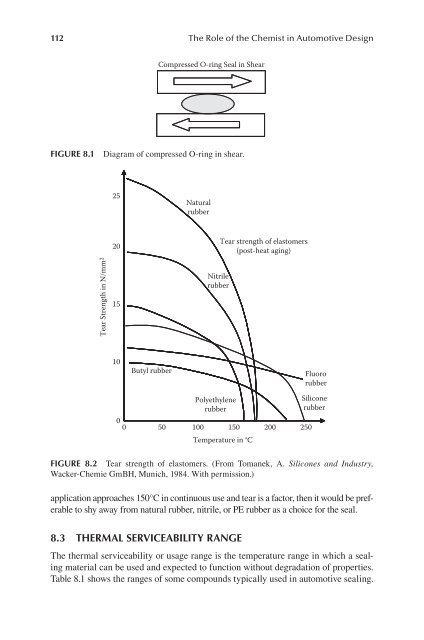- Page 2:
THE ROLE OF THE CHEMIST IN AUTOMOTI
- Page 5 and 6:
CRC Press Taylor & Francis Group 60
- Page 8 and 9:
Contents Preface...................
- Page 10 and 11:
Contents ix 6.6 Thermal Properties
- Page 12:
Contents xi 11.4 Glass Microspheres
- Page 16:
The Author Herman Phlegm was born i
- Page 19 and 20:
2 The Role of the Chemist in Automo
- Page 21 and 22:
4 The Role of the Chemist in Automo
- Page 23 and 24:
6 The Role of the Chemist in Automo
- Page 25 and 26:
8 The Role of the Chemist in Automo
- Page 27 and 28:
10 The Role of the Chemist in Autom
- Page 29 and 30:
12 The Role of the Chemist in Autom
- Page 31 and 32:
14 The Role of the Chemist in Autom
- Page 33 and 34:
16 The Role of the Chemist in Autom
- Page 35 and 36:
18 The Role of the Chemist in Autom
- Page 37 and 38:
20 The Role of the Chemist in Autom
- Page 39 and 40:
22 The Role of the Chemist in Autom
- Page 41 and 42:
24 The Role of the Chemist in Autom
- Page 43 and 44:
26 The Role of the Chemist in Autom
- Page 45 and 46:
28 The Role of the Chemist in Autom
- Page 48 and 49:
3 3.1 IntroductIon Component Materi
- Page 50 and 51:
Component Materials in Automobiles
- Page 52 and 53:
Component Materials in Automobiles
- Page 54 and 55:
Component Materials in Automobiles
- Page 56 and 57:
Component Materials in Automobiles
- Page 58 and 59:
Component Materials in Automobiles
- Page 60:
Component Materials in Automobiles
- Page 63 and 64:
46 The Role of the Chemist in Autom
- Page 65 and 66:
48 The Role of the Chemist in Autom
- Page 67 and 68:
50 The Role of the Chemist in Autom
- Page 69 and 70:
52 The Role of the Chemist in Autom
- Page 71 and 72:
54 The Role of the Chemist in Autom
- Page 73 and 74:
56 The Role of the Chemist in Autom
- Page 75 and 76:
58 The Role of the Chemist in Autom
- Page 77 and 78: 60 The Role of the Chemist in Autom
- Page 79 and 80: 62 The Role of the Chemist in Autom
- Page 81 and 82: 64 The Role of the Chemist in Autom
- Page 83 and 84: 66 The Role of the Chemist in Autom
- Page 85 and 86: 68 The Role of the Chemist in Autom
- Page 87 and 88: 70 The Role of the Chemist in Autom
- Page 89 and 90: 72 The Role of the Chemist in Autom
- Page 91 and 92: 74 The Role of the Chemist in Autom
- Page 93 and 94: 76 The Role of the Chemist in Autom
- Page 95 and 96: 78 The Role of the Chemist in Autom
- Page 98 and 99: 6 6.1 IntroductIon Engineering Poly
- Page 100 and 101: Engineering and Structural Polymers
- Page 102 and 103: Engineering and Structural Polymers
- Page 104 and 105: Engineering and Structural Polymers
- Page 106 and 107: Engineering and Structural Polymers
- Page 108 and 109: Engineering and Structural Polymers
- Page 110: Engineering and Structural Polymers
- Page 113 and 114: 96 The Role of the Chemist in Autom
- Page 115 and 116: 98 The Role of the Chemist in Autom
- Page 117 and 118: 100 The Role of the Chemist in Auto
- Page 119 and 120: 102 The Role of the Chemist in Auto
- Page 121 and 122: 104 The Role of the Chemist in Auto
- Page 123 and 124: 106 The Role of the Chemist in Auto
- Page 125 and 126: 108 The Role of the Chemist in Auto
- Page 130 and 131: Seal and Gasket Design 113 table 8.
- Page 132 and 133: Seal and Gasket Design 115 The main
- Page 134 and 135: Seal and Gasket Design 117 Properti
- Page 136 and 137: Seal and Gasket Design 119 table 8.
- Page 138 and 139: Seal and Gasket Design 121 within t
- Page 140 and 141: Seal and Gasket Design 123 F F F F
- Page 142 and 143: Seal and Gasket Design 125 R R O ma
- Page 144 and 145: Seal and Gasket Design 127 stabiliz
- Page 146 and 147: 9 9.1 IntroductIon HVAC System Over
- Page 148 and 149: HVAC System Overview and Refrigeran
- Page 150 and 151: HVAC System Overview and Refrigeran
- Page 152 and 153: HVAC System Overview and Refrigeran
- Page 154 and 155: HVAC System Overview and Refrigeran
- Page 156 and 157: HVAC System Overview and Refrigeran
- Page 158 and 159: HVAC System Overview and Refrigeran
- Page 160 and 161: HVAC System Overview and Refrigeran
- Page 162 and 163: HVAC System Overview and Refrigeran
- Page 164 and 165: HVAC System Overview and Refrigeran
- Page 166: HVAC System Overview and Refrigeran
- Page 169 and 170: 152 The Role of the Chemist in Auto
- Page 171 and 172: 154 The Role of the Chemist in Auto
- Page 173 and 174: 156 The Role of the Chemist in Auto
- Page 175 and 176: 158 The Role of the Chemist in Auto
- Page 177 and 178:
160 The Role of the Chemist in Auto
- Page 179 and 180:
162 The Role of the Chemist in Auto
- Page 181 and 182:
164 The Role of the Chemist in Auto
- Page 183 and 184:
166 The Role of the Chemist in Auto
- Page 185 and 186:
168 The Role of the Chemist in Auto
- Page 187 and 188:
170 The Role of the Chemist in Auto
- Page 189 and 190:
172 The Role of the Chemist in Auto
- Page 191 and 192:
174 The Role of the Chemist in Auto
- Page 193 and 194:
176 The Role of the Chemist in Auto
- Page 195 and 196:
178 The Role of the Chemist in Auto
- Page 197 and 198:
180 The Role of the Chemist in Auto
- Page 199 and 200:
182 The Role of the Chemist in Auto
- Page 201 and 202:
184 The Role of the Chemist in Auto
- Page 203 and 204:
186 The Role of the Chemist in Auto
- Page 205 and 206:
188 The Role of the Chemist in Auto
- Page 207 and 208:
190 Index Carbon dioxide emissions,
- Page 209 and 210:
192 Index heat exchanger designatio
- Page 211 and 212:
194 Index Power train, 95 Power tra







